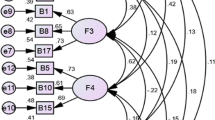Abstract
Purpose
This study aims to develop the Chinese version of the Sexual Function after Gynecologic Illness Scale (SFAGIS) and to establish its psychometric properties in Hong Kong Chinese patients with gynecological cancer.
Methods
A Chinese version of SFAGIS was developed using the Brislin model of translation and guidelines for cross-cultural adaptation of scales. The content validity and semantic equivalence were assessed by an expert panel. The translated version of SFAGIS was administered to 150 Hong Kong Chinese women with gynecological cancer to test the scale’s psychometric properties and to assess its feasibility. The convergent validity of the Chinese scale was tested by correlating it with the Chinese version of the sex relations subscale of the Psychosocial Adjustment to Illness Scale Self-Report (PAIS-SR).
Results
The average completion time for the Chinese SFAGIS was 16.2 ± 6.6 min. The internal consistency of the Chinese SFAGIS was 0.93. Test–retest reliability was also high with an interclass correlation coefficient 0.76. A Pearson product–moment correlation found strong correlations among the Chinese SFAGIS and the Chinese version of the sex relations subscale of the PAIS-SR, indicating that both scales measure the same as or has a similar construct.
Conclusions
The Chinese version of SFAGIS is a reliable and valid instrument which can be used in clinical practice and research for assessing sexual function problems in Chinese patients with gynecological cancer and to identify those in need of attention.
Similar content being viewed by others
References
Wilmoth MC, Spinelli A (2000) Sexual implications of gynecologic cancer treatments. J Obstet Gynecol Neonatal Nurs 29:413–421
Tangjitgamol S, Manusirivithaya S, Hanprasertpong J, Kasemsarn P, Soonthornthum T, Leelahakorn S, Thawaramara T, Lapcharoen O (2007) Sexual dysfunction in Thai women with early-stage cervical cancer after radical hysterectomy. Int J Gynecol Cancer 17:1104–1112
National Cancer Institute (2012) Sexuality and reproductive issues. http://www.cancer.gov/cancertopics/pdq/supportivecare/sexuality/HealthProfessional. Accessed 3 Jan 2012
Stead ML, Brown JM, Fallowfield L, Selby P (2003) Lack of communication between healthcare professionals and women with ovarian cancer about sexual issues. Br J Cancer 88:666–671
Molassiotis A, Chan CWH, Yam BMC, Chan SJ (2000) Quality of life in Chinese women with gynaecological cancers. Support Care Cancer 8:414–422
Hong Kong Cancer Registry, Hospital Authority (2011) Summary of cancer statistics in Hong Kong in 2009. Hong Kong, Hospital Authority. http://www3.ha.org.hk/cancereg/. Accessed 26 Oct 2011
Chinese Center for Disease Control and Prevention (2010) Cervical cancer: the most common cancer among Chinese women. China, Chinese Center for Disease Control and Prevention. http://www.chinacdc.net.cn/n272442/n272530/n272817/n272877/10663.html. Accessed 9 Feb 2010
Cang-Wong C, Murphy SO, Adelman T (2009) Nursing responses to transcultural encounters: what nurses draw on when faced with a patient from another culture. Permanente J 13:31–37
Cull AM (1992) The assessment of sexual function in cancer patients. Eur J Cancer 28A:1680–1686
Derogatis LR (1986) The Psychosocial Adjustment to Illness Scale (PAIS). J Psychosom Res 30:77–91
Chow KM, So WKW, Chan CWH (2010) Assessing sexual function amongst Hong Kong Chinese patients with gynecological cancer: translation and validation of the Sexual function-Vaginal changes Questionnaire (SVQ). Clin Oncol Cancer Res 7:230–233
Zeng YC, Li Q, Li X, Loke AY (2012) Chinese women’s sexuality concerns after gynecologic cancer. Cancer Nurs 35:257–264
Tang CSK, Siu BN, Lai FDM, Chung TKH (1996) Heterosexual Chinese women's sexual adjustment after gynecological cancer. J Sex Res 33:189–195
Gu C, Chan CWH, Twinn SF (2010) How sexual history and knowledge of cervical cancer and screening influence Chinese women’s screening behavior in Mainland China. Cancer Nurs 33:445–453
Gu C, Chan CWH, Twinn SF, Choi KC (2011) The influence of knowledge and perception of the risk of cervical cancer on screening behavior in mainland Chinese women. Psychooncology 31:1299–1308
Bransfield DD, Horiot JC, Nabid A (1984) Development of a scale for assessing sexual function after treatment for gynecologic cancer. J Psychosoc Oncol 2:3–19
Beaton DE, Bombardier C, Guillemin F, Ferraz MB (2000) Guidelines for the process of cross-cultural adaptation of self-report measures. Spine 25:3186–3191
Brislin RW (1986) The wording and translation of research instrument. In: Lonner WJ, Berry JW (eds) Field methods in cross-cultural research. Sage Publications, Hong Kong, pp 137–164
Polit DF, Beck CT, Hungler BP (2001) Essentials of nursing research: methods, appraisal, and utilization, 5th edn. Lippincott, Philadelphia
Frumovitz M, Sun CC, Schover LR, Munsell MF, Jhingran A, Wharton JT, Eifel P, Bevers TB, Levenback CF, Gershenson DM, Bodurka DC (2005) Quality of life and sexual functioning in cervical cancer survivors. J Clin Oncol 23:7428–7436
Gotay C, Farley JH, Kawamoto CT, Mearig A (2008) Adaptation and quality of life among long-term cervical cancer survivors in the military health care system. Mil Med 173:1035–1041
Jensen PT, Groenvold M, Klee MC, Thranov I, Petersen MA, Machin D (2003) Early-stage cervical carcinoma, radical hysterectomy, and sexual function. Cancer 100:97–106
Acknowledgments
The authors would like to acknowledge Dr. Tony Mok and Dr. Sheila Twinn.
Conflict of interest
There are no potential conflicts of interest.
Author information
Authors and Affiliations
Corresponding author
Rights and permissions
About this article
Cite this article
Chow, K.M., Chan, C.W.H., Choi, K.C. et al. Psychometric properties of the Chinese version of Sexual Function after Gynecologic Illness Scale (SFAGIS). Support Care Cancer 21, 3079–3084 (2013). https://doi.org/10.1007/s00520-013-1890-8
Received:
Accepted:
Published:
Issue Date:
DOI: https://doi.org/10.1007/s00520-013-1890-8



